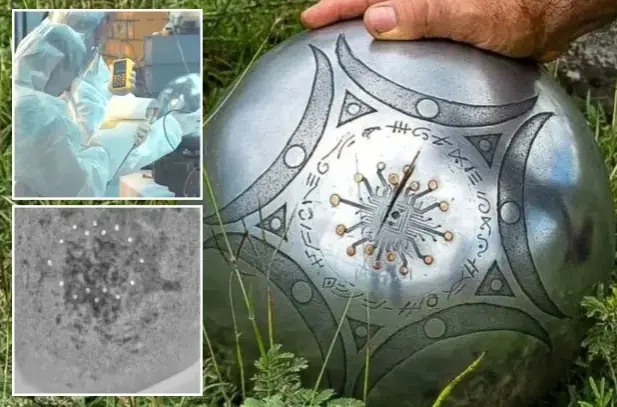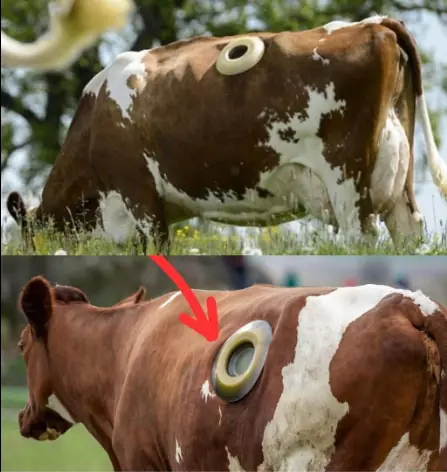
A Dark Line on the Fingernail: A Visual Signal That Should Not Be Ignored
A Dark Line on the Fingernail: A Visual Signal That Should Not Be Ignored

In a recent alarming yet insightful story, a man noticed a dark line appearing on his fingernail — a detail that might seem trivial or cosmetic to many but turned out to be a vital health warning. The man captured a photo of the line and sought medical guidance, ultimately bringing awareness to an important, often overlooked sign of potential illness.
This incident sheds light on the significance of nail changes as indicators of underlying health issues and stresses the importance of early detection and medical consultation.
The Story Behind the Photo
The man, whose identity remains private, took a photograph of a dark vertical line that had developed under his fingernail. Upon showing the photo to his doctor, he received an urgent warning that this seemingly small symptom could be a sign of a serious medical condition, including melanoma, a dangerous form of skin cancer.
Doctors emphasize that while many nail changes are benign and result from trauma or harmless pigment variations, certain types of dark lines on the nails, especially new, unexplained, or changing streaks, require prompt evaluation.




What Does a Dark Line on the Nail Mean?
The dark streak, medically known as melanonychia, manifests as a brown or black line running along the length of the nail. It occurs when pigment-producing cells called melanocytes deposit melanin in the nail plate. While melanonychia can result from harmless causes such as injury, medications, or fungal infections, it can also signal melanoma — a potentially life-threatening cancer.
Dr. Laura Smith, a dermatologist, explains:
"Melanonychia can be a benign condition, but when the pigmentation is new, widening, or accompanied by other changes such as nail splitting, bleeding, or a change in color, it warrants urgent medical review."
The photo that the man took served as a crucial tool for his physician to assess the pigmentation pattern, size, and characteristics of the line.
Medical Advice and the Importance of Early Detection
The medical community urges individuals not to overlook nail abnormalities, especially dark streaks that appear suddenly or grow over time. Early diagnosis of melanoma greatly improves treatment success and survival rates.
According to recent statistics, nail melanoma is a rare but serious form of skin cancer that accounts for approximately 0.7% to 3.5% of all melanoma cases worldwide. It often appears on the thumb or big toe but can occur on any nail.
Experts advise a prompt visit to a dermatologist if any of the following signs are noticed on the nails:
-
A new dark line or streak that was not present before
-
A line that is widening or changing in color or shape
-
Pigmentation extending onto the skin next to the nail (called Hutchinson’s sign)
-
Nail splitting, bleeding, or pain associated with the streak
Dr. Smith adds:
"Ignoring these symptoms can delay diagnosis and allow the melanoma to progress. That’s why awareness and proactive medical consultation are crucial."
How to Monitor Your Nails for Health
Nails can be mirrors of your overall health. Aside from melanoma, changes in nails can indicate other systemic conditions such as infections, nutritional deficiencies, or chronic diseases like diabetes or heart problems.
Here are some nail signs that could point to underlying health issues:
-
Pale or white nails: May indicate anemia or liver disease.
-
Yellow nails: Could signal fungal infections or lung disease.
-
Rippled or pitted nails: Might suggest psoriasis or connective tissue disorders.
-
Clubbing (rounded and bulbous nail tips): Associated with lung disease or heart problems.
Therefore, keeping an eye on your nails can serve as an early warning system.
What Should You Do If You Notice a Dark Line?
-
Do not panic: Many nail discolorations are harmless but still require evaluation.
-
Take clear photographs: Document changes over time to show to your healthcare provider.
-
Schedule a dermatologist appointment: They can perform a thorough exam and, if necessary, a biopsy to rule out melanoma or other conditions.
-
Avoid self-diagnosis: Internet searches or home remedies are not substitutes for professional advice.
Insights from Recent Studies on Nail Melanoma
A study published in the Journal of the American Academy of Dermatology highlights the challenges in diagnosing nail melanoma early, due to its rarity and resemblance to benign conditions. The research advocates for improved public awareness and clinician vigilance to reduce diagnostic delays.
Moreover, technological advances such as dermoscopy — a non-invasive skin imaging technique — have improved the ability to distinguish between benign and malignant nail pigmentations.
Personal Stories Highlighting the Importance of Nail Health
This recent case where a man’s photo prompted medical intervention is not isolated. Across the globe, many patients have reported discovering critical health issues after noticing unusual nail changes.
One patient shared:
"I thought it was just a bruise under my nail after hitting it, but the streak grew and changed colors. Thankfully, my doctor caught it early, and treatment was successful."
These stories underline the necessity for everyone to be attentive to their bodies, even in small details like nails.
The Role of Public Awareness Campaigns
Given the subtlety of nail melanoma’s presentation, health organizations worldwide have initiated awareness campaigns stressing that nail changes should never be ignored.
Educational programs focus on the ABCDEF rule for nail melanoma:
-
A: Age and race (more common in older adults and people with darker skin)
-
B: Band (width of the streak greater than 3 mm)
-
C: Change in the nail band or the nail itself
-
D: Digit involved (thumb, big toe, or index finger)
-
E: Extension of pigment onto the skin (Hutchinson’s sign)
-
F: Family or personal history of melanoma
These factors help clinicians decide which cases need biopsy.
Prevention and Protection Tips for Nail Health
While melanoma risk factors like genetics and UV exposure play roles, protecting your skin and nails remains key:
-
Avoid trauma to nails, which can cause pigmentation changes.
-
Wear gloves when handling chemicals or doing manual work.
-
Use sunscreen on exposed nail beds and surrounding skin.
-
Regularly inspect nails for any new or unusual changes.
Conclusion: Vigilance in the Smallest Details Can Save Lives
The simple act of taking a photo of a dark line on a fingernail led to a crucial medical discovery for one man — an example that underscores how minor physical changes can carry major health implications.
Nail changes should be monitored carefully, and any suspicious pigmentation warrants immediate medical evaluation. Health professionals emphasize that early detection is the best defense against serious diseases like melanoma.
If you notice unusual nail changes, remember:
"Your nails could be telling you more than you think. Listen carefully and act promptly."
News in the same category


Morning vs. Night Showers: Scientists Finally Reveal Which Is Best for Your Hygiene and Health

Budget Airlines Eye Standing-Style Seats to Boost Capacity by 20% Starting in 2026

Groundbreaking discovery: Scientists detect a new bacteria species that has NEVER been seen on Earth inside China’s Tiangong Space Station

Scientists astounded by rare footage capturing earth’s surface splitting along tectonic plates during Myanmar earthquake

Scientists Warn of Imminent Solar Storm Thre@t: Potential Global Blackouts and Widespread Travel Disruptions Loom

Revolutionary AI model from MIT predicts bre@st c@ncer years in advance, opening new frontiers in early detection

Young Woman Shares Three Overlooked C@ncer Symptoms Before Stage 4 Diagnosis

Why People Are Freaking Out Over Earth’s Changing Tilt: What You Need to Know

Why Do Flight Attendants Sit on Their Hands During Takeoff and Landing? The Safety Reason Explained

Controversy Over Use of Portholes to Access Cows’ Stomachs Sparks Debate on Animal Welfare and Agricultural Research

Volcano Warning Alerts Elevated: Possible Erupti0ns in Hawaii and Alaska

Melting arctic ice could unleash ancient 'z0mbie v!ruses': a growing concern

When Will Earth Run Out of Oxygen? Scientists Reveal the Timeline and What It Means for Humanity

One Month Before a Heart A::::ttack: Recognize These Vital Warning Signs

Pr0st@te C@ncer Risk Increases by 45% Among Men Who Skip Screening Appointments

Psychic Who Predicted COVID Warns of Future Global C@t@strophes

Unveiling the Untold Story of Jesus Christ’s Crucifixi0n: The Role of Longinus and Nicodemus

What Lies Beneath: Camera Dropped 305 Feet into Antarctic Ice Reveals Breathtaking Secrets of Earth’s Oldest Climate Record
News Post

10 Common Toxic Household Items and Safer Alternatives to Protect Your Health
Many everyday household products contain harmful chemicals, but simple, natural alternatives can keep your home safe and healthy.

AI deciphers the meaning of fallen ‘alien orb’ in Colombia, revealing chilling message

7-Day Meal Plan to Boost Energy: Foods to Eat, Avoid, and Tips for Lasting Vitality
Fuel your day with the right foods and habits—discover how to sustain your energy, avoid fatigue, and eat smart with our expert-backed 7-day meal plan.

Morning vs. Night Showers: Scientists Finally Reveal Which Is Best for Your Hygiene and Health

Spice Rack Essentials: Unlock the Health Benefits of Nature’s Most Powerful Flavors
Discover how everyday spices not only enhance your meals but also offer remarkable health benefits, from reducing inflammation to boosting heart and brain health.

Budget Airlines Eye Standing-Style Seats to Boost Capacity by 20% Starting in 2026

Healthier Food Swaps to Improve Your Family’s Diet
Simple swaps for a healthier diet: cut sugar, salt, and fat with easy food and drink alternatives.

‘Get Out, You Old C0w!’ Lawyer Returns from Work Early & Hears Wife Making His Mother Cry
Jammie’s lavish lifestyle crumbles when har$h truths confront her. With a mother-in-law’s quiet strength and a daughter’s innocence, she discovers that true wealth lies in love and responsibility. A heartfelt story of redemption and family.

Groundbreaking discovery: Scientists detect a new bacteria species that has NEVER been seen on Earth inside China’s Tiangong Space Station

An Herbalist’s Essential Summer First Aid Kit: Natural Remedies for Common Ailments
An Herbalist’s Summer First Aid Kit by Thelittleshine Most of us keep a first aid kit at home, don’t we? We keep things like anti-histamine tablets, bandaids, gauze and cotton, antiseptic cream etc., to treat cuts, burns, scrapes, rashes and more.

Scientists astounded by rare footage capturing earth’s surface splitting along tectonic plates during Myanmar earthquake

Kylie Padilla opens up about past childbirth complications, urges support for mothers
She further revealed the struggles she faced with b:reastfeeding her children, noting how the accumulated stress took a severe toll on her physical and mental health.

The 7 Best Times to Drink Water for Optimal Health and Energy
Stay hydrated the smart way: discover the best times to drink water for your health and energy.

Lawyer Provides Update on UK Teen Missing in Thailand, Found and Detained in Georgia Amid Drug Charges

Collagen Drops: The Ultimate Flaxseed Gel That Outperforms Botox for Youthful Skin
By embracing this DIY beauty secret, you’re not just caring for your skin; you’re investing in a sustainable, holistic, and personalized skincare routine that celebrates the wisdom of nature.

Scientists Warn of Imminent Solar Storm Thre@t: Potential Global Blackouts and Widespread Travel Disruptions Loom

Revolutionary AI model from MIT predicts bre@st c@ncer years in advance, opening new frontiers in early detection

The Ultimate 3-Step Korean Rice Skincare Routine for Glowing, Youthful Skin: DIY Guide to Achieve Glass Skin Naturally
By harnessing the gentle power of rice, aloe vera, vitamin E, and natural oils, you can create a soothing, hydrating, and brightening regimen that’s customizable and free from harsh chemicals.
